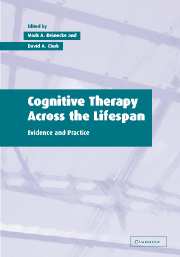Book contents
- Frontmatter
- Contents
- List of contributors
- Foreword
- 1 Cognitive therapy across the lifespan: conceptual horizons
- 2 Cognitive theory and therapy of depression
- 3 Cognitive theory and therapy of bipolar disorders
- 4 Regulation of emotion in generalized anxiety disorder
- 5 Cognitive theory and therapy of obsessions and compulsions
- 6 The cognitive model of panic
- 7 Treating obsessional problems using cognitive-behavioral therapy
- 8 Narcissistic personality disorder
- 9 Cognitive therapy and the self
- 10 Promoting cognitive change in posttraumatic stress disorder
- 11 Cognitive theory and therapy of social phobia
- 12 The cognitive model of bulimia nervosa
- 13 Cognitive therapy and schizophrenia
- 14 Cognitive-behavioral interventions for alcohol abuse and dependence
- 15 Cognitive approaches to understanding, preventing and treating child and adolescent depression
- 16 Cognitive-behavioral interventions in childhood anxiety disorders
- 17 Attention deficit/hyperactivity disorder
- 18 Cognitive-behavioral interventions for children with conduct problems
- 19 Processes of change in cognitive therapy
- 20 Cognitive therapy in the twenty-first century: current status and future directions
- Index
17 - Attention deficit/hyperactivity disorder
Published online by Cambridge University Press: 05 July 2014
- Frontmatter
- Contents
- List of contributors
- Foreword
- 1 Cognitive therapy across the lifespan: conceptual horizons
- 2 Cognitive theory and therapy of depression
- 3 Cognitive theory and therapy of bipolar disorders
- 4 Regulation of emotion in generalized anxiety disorder
- 5 Cognitive theory and therapy of obsessions and compulsions
- 6 The cognitive model of panic
- 7 Treating obsessional problems using cognitive-behavioral therapy
- 8 Narcissistic personality disorder
- 9 Cognitive therapy and the self
- 10 Promoting cognitive change in posttraumatic stress disorder
- 11 Cognitive theory and therapy of social phobia
- 12 The cognitive model of bulimia nervosa
- 13 Cognitive therapy and schizophrenia
- 14 Cognitive-behavioral interventions for alcohol abuse and dependence
- 15 Cognitive approaches to understanding, preventing and treating child and adolescent depression
- 16 Cognitive-behavioral interventions in childhood anxiety disorders
- 17 Attention deficit/hyperactivity disorder
- 18 Cognitive-behavioral interventions for children with conduct problems
- 19 Processes of change in cognitive therapy
- 20 Cognitive therapy in the twenty-first century: current status and future directions
- Index
Summary
Attention deficit/hyperactivity disorder (AD/HD; American Psychiatric Association, 1994) is the most recent in a long line of diagnostic labels used to describe individuals who display developmentally inappropriate levels of inattention, impulsivity, and/or hyperactivity. Prior to 1994, children displaying many of these same behavioral features might have been identified as having attention deficit disorder (ADD), hyperkinetic reaction of childhood, or minimal brain dysfunction. Although confusing to some, such changes in diagnostic terminology have not been without purpose. On the contrary, each labeling change has reflected important changes in the conceptualization of this disorder.
As recently as 15 years ago, it was not unusual to find people – lay individuals and healthcare professionals alike – who believed that AD/HD was a condition limited to childhood. Hence, the advice often given to parents was: “Hang in there, once children reach the teen years, they outgrow their AD/HD.” We now know that nothing could be further from the truth. Not only does AD/HD occur during adolescence, it can also be found among a significant number of adults. In light of this finding, most experts in the field today view AD/HD to be a chronic condition that persists across the lifespan (Weiss and Hechtman, 1993; Barkley, 1998).
Of what relevance is cognitive therapy to the clinical management of AD/HD? To answer this question, it is first necessary to have a better understanding of what AD/HD is, and howit presents itself across the lifespan.
- Type
- Chapter
- Information
- Cognitive Therapy across the LifespanEvidence and Practice, pp. 418 - 440Publisher: Cambridge University PressPrint publication year: 2003
- 1
- Cited by



